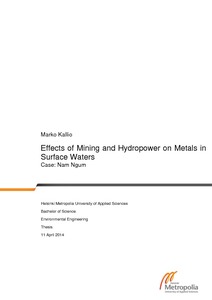| dc.contributor.author | Kallio, Marko | |
| dc.date.accessioned | 2014-05-19T10:23:33Z | |
| dc.date.available | 2014-05-19T10:23:33Z | |
| dc.date.issued | 2014 | |
| dc.identifier.uri | URN:NBN:fi:amk-201405198467 | |
| dc.identifier.uri | http://www.theseus.fi/handle/10024/75687 | |
| dc.description.abstract | Nam Ngum, a river in Lao PDR, is experiencing rapid development of hydropower and mining. Hydropower dams may influence the water quality via sediment trapping and hydrology changes. They also create barriers for migration of aquatic animals. Mining, on the other hand, has potential severely impair water quality in their surroundings.
Nam Ngum River Basin is located north of Vientiane. The watershed contains tropical and sub-tropical areas of distinct dry and wet seasons. It is divided in mountainous Upper Nam Ngum (The area upstream from the dam Nam Ngum 1) and relatively flat Lower Nam Ngum in Vientiane Plains. Mining operations are largely located in the upper part of the watershed, with only a few mines located in the lower part.
Mining operations usually impact surrounding water bodies. Acid Mine Drainage brings water of low pH and high metal content into streams. Runoff from the mining sites has a high concentration of suspended solids. Because of the affiliation of metals to adhere to solid particles (instead of being in a soluble form) in the water column, sediment transport becomes a major factor in the distribution of mine related pollution of waters. Polluted sediments get transported into reservoirs or lakes where they may leach out into solution in anoxic, low pH conditions.
Where water quality data is available (mostly in the Lower Nam Ngum), no sign of mining related pollution could be traced. The major mining sites are far upstream and beyond several reservoirs that trap contaminants. In the Nam Ngum, mining pollution seems to be concentrated in the area where water quality data is not currently available.
A water quality monitoring programme is suggested which addresses the gaps of sampling network in the Nam Ngum. A set of 7 new stations, 10 existing ones and cooperation with mining and hydropower companies would create a monitoring network for efficient management of the water resource for all stakeholders. With recent developments in water quality monitoring and industrial development, Nam Ngum may have the potential to become a benchmark watershed of water resource management in south-east Asia. | en |
| dc.language.iso | eng | |
| dc.publisher | Metropolia Ammattikorkeakoulu | |
| dc.rights | All rights reserved | |
| dc.title | Effects of Mining and Hydropower on Metals in Surface Waters : Case: Nam Ngum | en |
| dc.type.ontasot | fi=AMK-opinnäytetyö|sv=YH-examensarbete|en=Bachelor's thesis| | |
| dc.identifier.dscollection | 10024/235 | |
| dc.organization | Metropolia Ammattikorkeakoulu | |
| dc.contributor.organization | Metropolia Ammattikorkeakoulu | |
| dc.subject.keyword | mining | |
| dc.subject.keyword | water | |
| dc.subject.keyword | dam | |
| dc.subject.keyword | reservoir | |
| dc.subject.keyword | water quality | |
| dc.subject.keyword | heavy metals | |
| dc.subject.specialization | Water Management | |
| dc.subject.degreeprogram | fi=Energia- ja ympäristötekniikka|sv=Energi- och miljöteknik|en=Energy and Environmental Engineering| | |
| dc.subject.discipline | Environmental engineering (in English) | |
